In the competitive world of skincare marketing, standing out from the crowd is no easy feat. However, implementing the right skincare marketing strategies can work wonders when it comes to elevating your beauty business. From defining your brand identity to optimizing your web presence and cultivating brand advocates, this guide covers the essential tactics to make your products shine.
Follow our comprehensive, 6-step methodology below designed specifically for emerging and established skincare brands ready to glow up. Let’s dive in!
1. Conduct Market Research
Kicking off any skincare marketing campaign requires in-depth consumer and competitor analysis. This upfront research is invaluable for steering your messaging, positioning new launches, and gaining actionable insights your team can act on.
Advanced Competitive Analysis Tools
Today’s competitive intelligence gathering is powered by sophisticated analytics tools. Among these tools, the following are particularly helpful:
- SEMrush: For paid and organic search analysis into how rivals are bidding on industry keywords like “anti-aging serum” or “acne spot treatment.” Track their digital ad spend across Google and social channels through SEMrush’s automated reporting.
- BuzzSumo: Review competitor content strategies, see which specific articles or formats like lists or videos earn the most backlinks and amplification to borrow learnings.
- Google Analytics: Though focused on owned data, can still provide macro-industry level website traffic analysis by plugging in rival domains. Determine seasonal fluctuations across skincare overall.
Competitive Analysis Framework and Best Practices
Identify common themes across top-performing brands in your niche. For example, set up a spreadsheet to meticulously track and analyze their marketing strategies, product launches, social media engagement, campaign themes, and customer reviews. By doing so, you can uncover patterns in their success and adapt those strategies within your own brand’s context. This could involve understanding their storytelling techniques, the type of influencers they collaborate with, or the specific hashtags they use to gain traction. With this comprehensive analysis, you’ll be better equipped to make informed decisions that could propel your brand forward in the competitive skincare market.
Start by analyzing 10-15 of your top competitors across parameters like:
- Product range and pricing
- Brand personas and messaging
- Website design and content strategy
- Social media presence and campaigns
- Advertising and partnerships
- Ratings, reviews, and complaints
Leveraging Social Listening for Real-Time Market Insights
Today’s market research goes beyond old-school questionnaires, leveraging cutting-edge social listening platforms that sift through countless online dialogues about skincare.
- Sprout Social: Enables tracking brand, product or industry keyword mentions across social networks, news sites and more to collect real-time feedback or unsatisfied customer complaint insights that require reputation management.
- Awario: In addition to monitoring ongoing discussions, Awario performs historical social data analysis offering perspective on sharable content types or viral posts catching fire to identify success attributes.
Qualitative and Quantitative Research Methodology
Combine competitive analysis with your own primary and secondary research. This involves conducting surveys, engaging in social media monitoring, and analyzing consumer behavior patterns. By integrating data from various sources, you can form a more comprehensive understanding of the market landscape, identify emerging trends, and uncover gaps in the competitive offerings. This multifaceted approach allows you to craft skincare marketing strategies that are not only informed by what competitors are doing but also by the direct feedback and preferences of your target audience. Consider the following:
- Customer surveys asking about buying preferences, values, brand loyalty, and satisfaction
- Focus groups recruiting existing and potential customers to test concepts
- Individual interviews speaking to influencers, partners, and industry experts
- Analysis of interactions on digital channels like reviews, social comments, and forum discussions
Platforms like Statusphere also enable skincare brands to gather first-party data from thousands of micro-influencers. This eliminates guesswork by connecting you to creators that match your ideal customer profile. Their authentic feedback provides invaluable direction for your skincare marketing.
Case Studies: Real-World Applications of Market Research
Brilliant market research that informs strategy and product development can lead to significant advancements within a category. The success of leading brands can be traced to astutely identifying significant gaps or opportunities through market analysis, then launching strategically crafted products directly addressing consumer needs highlighted. This underscores the incredible value of research informing development.
Some standout examples include:
Brand In Focus: Fenty Beauty
- Market Research Showed: Significant unmet demand for inclusive foundation shades for diverse skin tones beyond light categories
- Product Strategy: Launched with a record 40 foundation shades across a very broad color spectrum, including specific undertone varieties
- Impact: Explosive demand from underserved audiences, accelerating awareness of diversity in beauty
Brand In Focus: The Inkey List
- Market Research Showed: Consumer desire for simplified routines with hero ingredients like hyaluronic acid, not complex 10-step regimens
- Product Strategy: Streamlined formulations focusing on 1-2 star ingredients per product at accesible price points
- Impact: Built brand loyalty among users seeking straightforward effectiveness
Brand In Focus: Curology
- Market Research Showed: Customization and skin expert guidance were in high demand as DTC models/subscriptions rose
- Product Strategy: Created personalized monthly prescription formulas tailored to each customer’s unique skin needs
- Impact: Became leading brand disrupting dermatology access by pairing personalization with telemetry
Craft Detailed User Personas and Use Cases
With market research complete, distill your key findings into 3 to 5 core user personas with detailed use cases. This not only helps to clarify your target demographic but also enables you to tailor your skincare marketing strategies to meet the specific needs and preferences of each persona. By understanding the unique challenges and desires of these segmented groups, you can create more effective, personalized skincare marketing campaigns. For example, consider:
- Gender identity, age range, and location
- Media consumption and shopping habits
- Values, priorities, and pain points
- Typical skincare routines and product preferences
- Preferred brands and influencers
- Motivations for purchase and brand selection
These user journeys humanize your target groups beyond basic demographics. They also help identify exactly how and where your products fit into consumers’ daily lives. Adjust personas constantly as new customer data comes in.
2. Build Your Brand Identity and Value Proposition
With actionable personas guiding your work, building a consistent brand identity is next. This step is about defining your essence and differentiation as a company.
By adhering to consistency and communicating values through branding decisions, skincare brands both large and small can shape an engaging brand image that endures and captivates long-term.
Crafting a Compelling Brand Persona: Templates and Examples
Your brand persona is a semi-fictional character that embodies the characteristics of your brand. Here is a simple template to get started:
- Background: Brief history and origins of the brand.
- Vision: What future does the brand aspire to create?
- Values: Core principles that guide the brand’s actions and decisions.
- Personality: Human characteristics attributed to the brand (e.g. friendly, professional, innovative).
- Voice: How the brand communicates (e.g. tone, language, style).
- Visual Identity: Logos, color schemes, typography, and imagery that represent the brand visually.
Examples:
- The Ordinary has crafted a brand persona around simplicity and transparency, focusing on single-ingredient-driven products. Their straightforward communication style and no-frills packaging have resonated with consumers seeking efficacy without complexity.
- Glossier has established itself with a persona that emphasizes beauty in real life, advocating for skin-first makeup second. Their approachable tone and millennial-pink packaging have become iconic, appealing to a demographic that values authenticity and community.
- Kiehl’s leans on its apothecary heritage, highlighting scientific expertise and personalized customer service. Their brand persona is that of a trusted, knowledgeable friend in skincare, with stores designed to feel like old-world pharmacies.
Streamline Your Value Proposition
With your brand persona clear, craft a lean value proposition stating exactly how you solve customer needs better than alternatives. Crafting a compelling value proposition is an art that involves distilling your brand’s essence into a clear, concise, and persuasive statement. It’s the promise you make to your customers that differentiates you from the competition and articulates the unique benefits they will receive. To help your skincare brand define its value proposition, consider the following exercises and questions:
Exercise 1: The “Why” Behind Your Brand
- What inspired the creation of your skincare brand?
- What skincare issues does your brand aim to solve?
- Why should customers choose your products over others?
Exercise 2: Identifying Your Unique Selling Points (USPs)
- List the features and benefits of your products. How do they improve the customer’s life?
- Are your products made with unique ingredients or through innovative processes?
- What experience do you offer that customers can’t find elsewhere?
Exercise 3: Understanding Your Customer
- Who is your ideal customer, and what are their skin concerns and desires?
- How does your brand align with the lifestyle and values of your target audience?
- In what ways can your products contribute to their daily skincare routine?
Exercise 4: The Elevator Pitch
- Can you summarize your brand’s value proposition in a sentence or two that captivates interest?
- Does your pitch convey the emotional benefits and outcomes of using your products?
Questions to Refine Your Value Proposition
- How does your brand improve the customer’s self-perception or day-to-day life?
- What specific and measurable value does your product provide?
- How can you prove the claims you’re making? (Consider testimonials, clinical studies, etc.)
When crafting your proposition, it’s important to remember that the essence of what you’re offering is not just a product, but a promise to your customers. This promise should encapsulate the benefits and experiences that your brand delivers, distinguishing it from the competition. It’s the core message that will resonate with your audience, informing them why your skincare products are their best choice. Remember to:
- Limit yourself to 1-3 concise benefit-driven statements
- Benchmark against competitors by name when appropriate
- Quantify your advantage through metrics like “20% higher potency”
- Test propositions directly with target users for resonance
Examples:
- La Roche-Posay’s value proposition focuses on dermatologist-tested formulations for sensitive skin, leveraging their French pharmacy heritage and thermal spring water as unique selling points.
- Bioderma emphasizes its commitment to dermatological safety, offering a range of cleansing and care products designed for various skin types, with a particular focus on their micellar water, a pioneering product that has become a staple in skincare routines worldwide.
- Cetaphil is renowned for its gentle skincare formulas, catering to those with sensitive or dry skin. Their value proposition is built around simplicity and trust, providing no-fuss, dermatologist-recommended products for everyday use.
- Murad stakes its claim with a value proposition centered on the science of cellular hydration, targeting a broad range of skin concerns with products that promise to deliver hydration and rejuvenation at the cellular level.
Differentiation Strategies for a Crowded Market
Differentiation is crucial in a saturated market like skincare. Here are strategies to consider:
- Storytelling: Weave a compelling narrative around your brand’s founding, the journey of your products from concept to creation, and the lives they touch. For example, Chantecaille structures collections around seasons like spring blooms while Dr. Hauschka advocates facial massage rituals.
- Brand Heritage: Emphasize your brand’s history and tradition if it has a long-standing heritage. This can create an emotional connection and a sense of trust with consumers. For example, Tatcha traces its founder’s discovery of geisha skincare secrets passed through generations while Estée Lauder highlights its name sake’s founding.
- Customer Experience: Go beyond the product to offer exceptional customer service, personalized consultations, and engaging in-store experiences. La Prairie has cultivated an unparalleled reputation for exclusivity matched by its elevated consultation-driven facials at selected Neiman Marcus department store locations and high-end spas.
To help isolate opportunities for skincare brand differentiation, start by conducting a thorough analysis of your market environment to identify potential areas where your brand can truly stand out.
Make an exhaustive competitor list spanning direct and adjacent players then scrutinize areas like branding, pricing and products comprehensively. Then, pinpoint 3 unique selling proposition angles you can leverage to make your brand stand out among alternatives in market. Your identity should spotlight these differentiation factors.
For example, Neutrogena’s dermatologist-recommended products, CeraVe’s skin barrier health emphasis and La Roche-Posay’s proprietary thermal spring water are all unique selling propositions setting each brand apart.
3. Improve Your Website UX
Imagine an avid skincare enthusiast named Sarah. She’s explored everything The Ordinary has to offer and wants to trial a clean indie brand. She lands on your site – what should Sarah see in those crucial 10 seconds before she bounces?
Checklist for Optimization
To ensure Sarah, and others like her, have the best experience on your site, follow this detailed checklist:
- Page Load Speed: Use tools like Google PageSpeed Insights to measure and improve loading times.
- Mobile-Friendliness: Test your site on various devices with Google’s Mobile-Friendly Test.
- Navigation Ease: Ensure intuitive menu structure and a clear path to purchase.
- Accessibility Standards: Adhere to WCAG guidelines to make your site usable for all.
- Clear CTAs: Position calls-to-action prominently to guide users.
- Quality Content: Provide engaging and informative content that is easy to read.
- Visual Hierarchy: Use layout to prioritize key information.
- Consistent Branding: Maintain brand elements throughout the site to reinforce identity.
Understanding User Needs
Imagine a skincare aficionado like Sarah, who’s just beginning her journey into the world of clean beauty brands. She’s eager to learn and ready to be impressed by what your brand has to offer. To captivate Sarah and others like her, it’s crucial to use a comprehensive suite of data collection methods that provide a deep understanding of your audience. Tools like Google Analytics can be instrumental in gathering detailed demographic and behavior insights, which can help identify patterns in how different user segments interact with your brand. These insights can then be enriched with qualitative data from social listening tools and focus group discussions, giving you a window into the emotional aspects and unmet needs of your audience. It’s about creating a connection that resonates with Sarah’s values and addresses her skincare goals. Essential aspects to consider are:
- Demographics: Collect extensive data on age, geographical location, gender, and even technographics like device usage and preferred communication channels. This demographic data provides a foundation for understanding who your audience is and how they might prefer to engage with your brand.
- Psychographics: Delve into the values, attitudes, and lifestyles that influence your audience’s skincare choices. Investigate their beliefs around skincare, preferred ingredients, and their overall level of knowledge and interest in skincare topics.
- Behavioral Patterns: Pinpoint where your audience spends their time online, from social media platforms to forums where skincare discussions thrive. Understand their search patterns, purchasing behaviors, and the typical journey they take from discovery to conversion, which can reveal critical touchpoints for engagement.
- Motivations: Uncover the deeper emotional triggers that lead to purchases. These could range from the desire for simpler skincare routines to concerns about aging, or a passion for the safety and efficacy of clean, sustainable ingredients.
- Challenges: Identify the common obstacles they encounter, such as overwhelming product assortments or confusion due to a lack of ingredient transparency. Understanding these pain points can guide you in simplifying the customer journey and clarifying your messaging.
- Direct Feedback: Utilize social listening tools to capture real-time discussions and genuine sentiments about your brand and products across various social media channels. This raw feedback offers unfiltered insights into how customers perceive your brand, what they love about your products, and areas where they feel there could be improvement.
By integrating these varied data sources, you can create a rich, multi-dimensional picture of your target audience. This allows for more precise targeting in your skincare marketing efforts, development of products that truly meet consumer needs, and crafting of messages that resonate deeply with your audience, ultimately leading to stronger brand loyalty and market success.
Personalization
As Sarah navigates your website, the personal touch in your UX design should be evident. By integrating direct conversations with users like Sarah and aligning these interactions with your established user personas, you can make informed adjustments to your site that resonate deeply with your audience. This personalized approach not only makes Sarah and others feel valued and heard but can also significantly boost their loyalty and engagement with your brand.
Leveraging algorithms, quizzes, integrations and expert advice, leading brands demonstrate how catering journeys to the individual facilitates more relevant discoveries and convenient experiences – the hallmarks of true personalization:
Brand In Focus: Curology
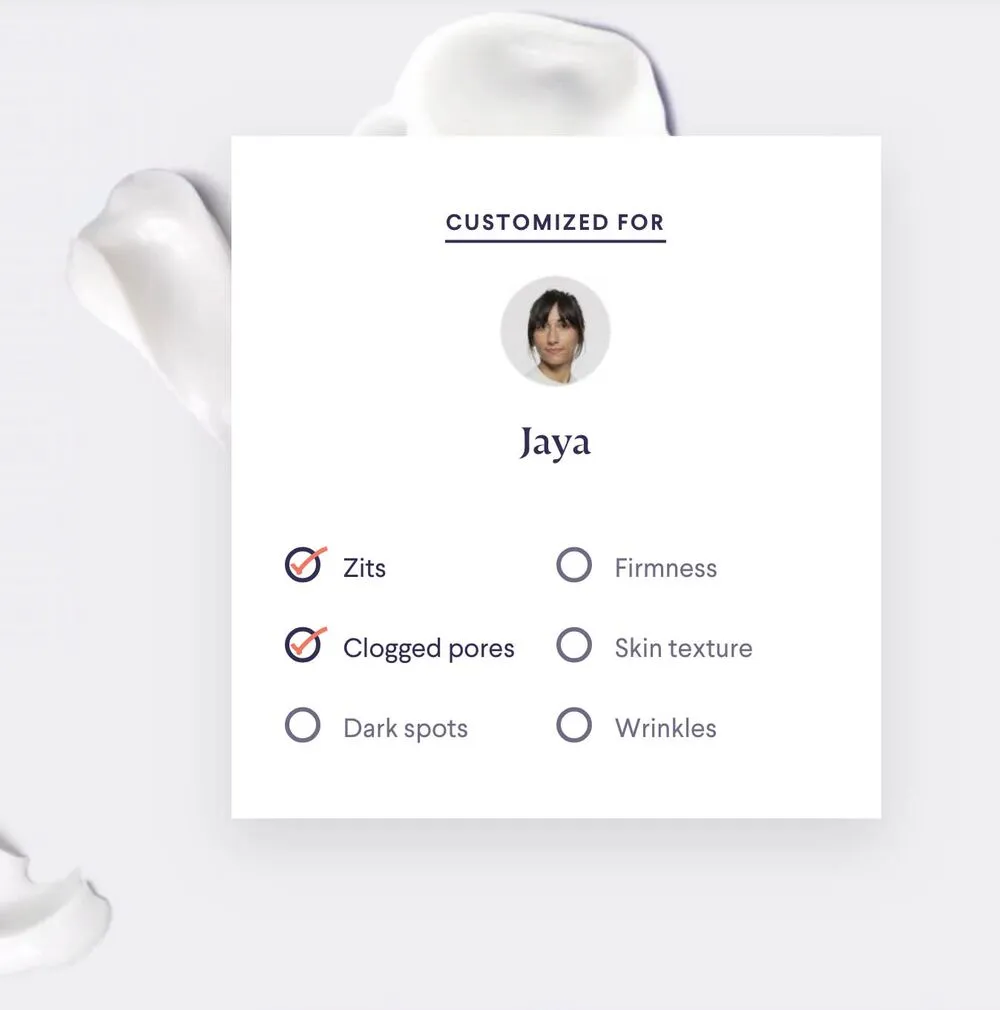
Curology takes personalization to the next level by offering a tailored skincare experience right on their website. Upon visiting, users are invited to engage in a custom formula quiz, which assesses their unique skin concerns and personalizes product recommendations. This approach ensures that each visitor is treated to a bespoke skincare journey, with Curology’s custom-crafted solutions designed to meet the individual needs of each user’s skin.
- Custom formula quiz provides personalized product recommendations
- Personalized regimen builder based on individual skin goals
- Tracker allows monitoring changes in skin over time
- Targeted emails based on purchase history and skin type
Brand In Focus: Paula’s Choice

Paula’s Choice capitalizes on on-site personalization to enhance the user experience and streamline the customer journey. By offering personalized skincare advice through quizzes and expert consultations, the brand ensures that each visitor receives tailored product recommendations. This individualized approach helps users cut through the clutter of product choices, making it easier to find solutions that align with their unique skin concerns and goals.
- Tailored routines generated from skin and hair quizzes
- Live chat connects users with skin experts
- Pop-ups serve suggestions based on browsing behavior
- Option to take a skin assessment consultation
Brand In Focus: Estée Lauder

Estée Lauder enhances the online shopping experience by embracing on-site personalization, ensuring that each visitor feels their individual beauty needs are understood and catered to.
- AI-powered diagnostic identifies user’s skin age for precise product matches
- Targeted sampling opportunities based on previous purchases
- App integrations enable accessing previous orders and tracking
- Loyalty rewards status unlocks exclusive personalized perks
4. Adopt a Multi-Channel Content Marketing Strategy
While your website may be the hub, fueling your digital ecosystem with value-driven content across channels is essential.
Build a Multi-Channel Content Marketing Presence
Content marketing is not just about selling products – it’s about educating, engaging, and connecting with consumers on a deeper level. This not only offers customers the necessary guidance to confidently make purchasing decisions, but also provides a unique and non-sales focused way for brands to engage with their audience. Since 79% of individuals are influenced by user-generated content, incorporating these themes into a content strategy can significantly increase engagement, build brand awareness, and provide valuable support to customer inquiries.
Here are some content ideas or themes that resonate well with skincare audiences:
- “How-To” Guides and Tutorials: Step-by-step content that educates consumers on how to use various skincare products effectively or how to perform certain skincare routines. For example, “How to Create a Nighttime Skincare Routine”.
- Ingredient Spotlights: Deep dives into the benefits and science behind specific skincare ingredients. This could include blog posts like “The Power of Hyaluronic Acid for Hydration” or video content featuring ingredient harvests or sourcing.
- Skincare Myths Debunked: Addressing common misconceptions and myths in the beauty industry to inform and educate consumers, such as “Do You Really Need to Drink 8 Glasses of Water a Day for Healthy Skin?”.
- Before and After Transformations: Sharing customer testimonials and before-and-after images to showcase product efficacy. This type of content can be very compelling and relatable.
- Seasonal Skincare Tips: Advice on how to adjust skincare routines for seasonal changes, such as “Winter Skincare Essentials to Combat Dry Skin”.
- Sustainability in Skincare: Discussing how the brand is addressing environmental concerns, like using sustainable packaging or sourcing eco-friendly ingredients.
- Behind the Brand: Sharing the brand’s story, values, and the people behind the products to build a personal connection with the audience.
- User-Generated Content: Featuring photos, reviews, and stories from real users to build community and trust. This could be in the form of social media posts, blog entries, or a dedicated section on the website.
- Skincare Challenges: Engaging the audience with 30-day skincare challenges that encourage them to try new products or routines and share their progress.
- Wellness and Lifestyle: Connecting skincare to overall wellness with content that covers topics like stress management, healthy eating, and exercise, and how these factors can affect skin health.
- Beauty and Skincare Trends: Keeping the audience up-to-date with the latest trends in skincare and beauty, such as the rise of K-beauty or the use of CBD in skincare products.
- Expert Interviews and Q&As: Hosting sessions with dermatologists, estheticians, or beauty industry experts to answer common skincare questions and provide professional insights.
- Skincare for Different Life Stages: Tailoring content for different age groups or life events, such as skincare during pregnancy, teenage acne solutions, or anti-aging strategies for mature skin.
- Cultural Perspectives on Skincare: Exploring skincare routines and philosophies from around the world to offer diverse perspectives and practices.
- DIY Skincare Recipes: Encouraging natural and homemade skincare solutions with recipes for masks, scrubs, and more, using ingredients that can be found at home.
Brand In Focus: Drunk Elephant
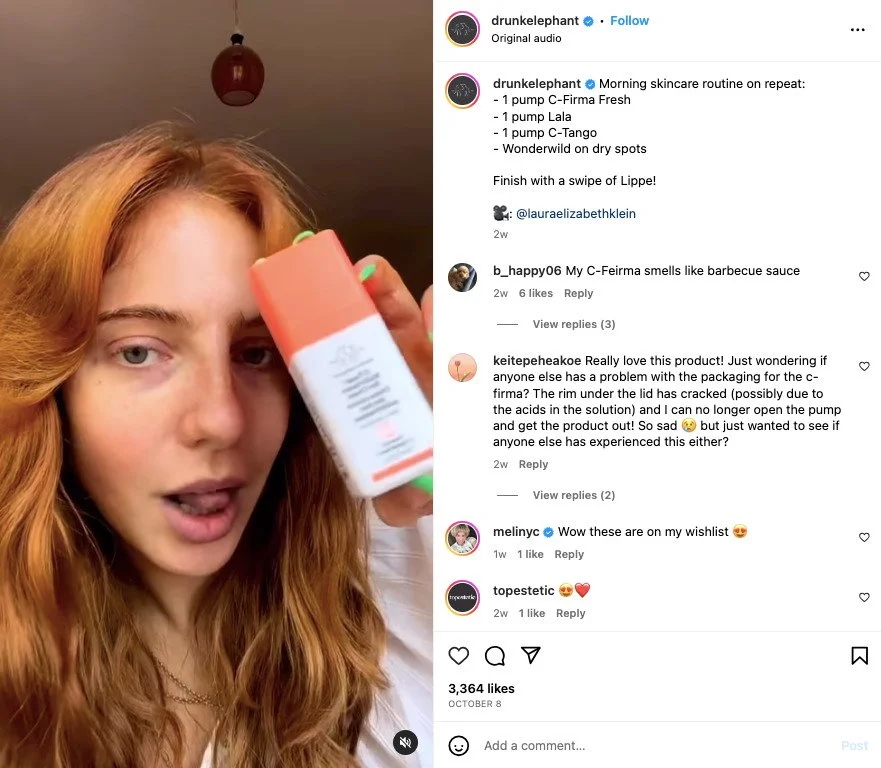
Drunk Elephant focus on educating consumers about the benefits of biocompatible skincare through a variety of engaging content formats. By leveraging the power of storytelling and user-friendly educational materials, Drunk Elephant creates a narrative that resonates with health-conscious consumers who value ingredient purity and product efficacy.
- Educational blog features ingredients and routines
- Playful Instagram posts highlight consumer generated joy
- TikTok campaign danced away acne stigma with #acnedance
- Email nurturing flows cover skin concerns
Brand In Focus: Sunday Riley

Sunday Riley creates a comprehensive content marketing ecosystem that educates, inspires, and cultivates a community of skincare enthusiasts. Their content marketing strategy is a reflection of their commitment to not only provide top-tier products but also to educate and engage their audience, utilizing an array of content formats to showcase their expertise and build trust with consumers.
- YouTube tutorials featuring the founder as a skin expert offer a personal touch, inviting users into the brand’s world of skincare science and application.
- Instagram spotlights celebrate consumer successes, sharing radiant results and real-life testimonials that underscore the brand’s impact.
- The Sunday Riley blog becomes a hub for well-being, connecting skin health to lifestyle choices and providing a holistic approach to beauty.
- An email loyalty program nurtures long-term relationships, driving retention through insider tips, exclusive offers, and early access to new products.
Brand In Focus: Fenty Skin
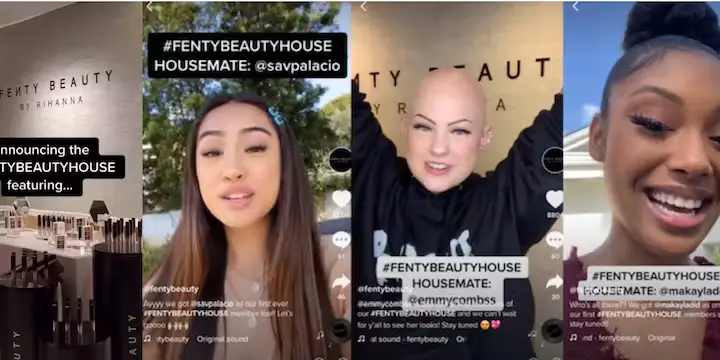
Fenty Skin, the skincare line by Rihanna, has been making waves with its cutting-edge approach to content marketing. Leveraging Rihanna’s star power and the brand’s inclusive ethos, Fenty Skin creates buzzworthy campaigns that resonate with a diverse audience.
- Bold Instagram imagery builds hype for launches
- Tiktok hashtag challenges inspire viral creation
- Influencer seeding on Youtube drives awareness
- Twitter chats create authentic engagement
Content Calendar
Develop a strategic content calendar to maintain a consistent publishing schedule across all channels. Here’s an example of what that might look like:
Weekly
- 2 blog posts on skincare tips and product education
- 3 Instagram posts featuring product highlights and customer testimonials
- 1 YouTube tutorial or product demonstration video
- Daily Instagram Stories with interactive polls, Q&A sessions, and behind-the-scenes content
Monthly
- 1 in-depth guide or white paper on skincare science or industry trends
- 2 customer story features across blog and email newsletter
- 1 webinar or live Q&A session focusing on skincare education
Quarterly
- Seasonal campaigns aligning with product launches or industry events
- Influencer collaboration videos or podcast episodes
Emerging Channels
Capitalize on emerging channels like TikTok and IGTV to reach younger demographics with content that’s native to their preferences:
- Create short, engaging TikTok videos that showcase quick skincare tips, challenges, or user-generated content.
- Use IGTV for longer-form content such as detailed tutorials, influencer takeovers, or deep dives into skincare routines.
- Encourage user interaction through hashtag challenges, duets, and reactions on TikTok.
- Optimize content for vertical viewing and leverage the platforms’ features for maximum engagement.
Metrics for Success
To gauge the effectiveness of your content marketing efforts, define KPIs for each channel:
- Engagement Rates: Track likes, comments, shares, and time spent on content.
- Conversion Rates: Measure the percentage of content viewers who take the desired action, such as making a purchase or signing up for a newsletter.
- ROI: Assess the return on investment by comparing the revenue generated from content marketing to the costs of producing and distributing content.
Regularly review these metrics to refine your strategy, focusing on the types of content and channels that yield the best results for your skincare brand.
Experiment with Emerging Formats Like Podcasts and Webinars
Podcasts continue to boom when it comes to skincare marketing, offering new avenues to start meaningful conversations with your community. For example, clean beauty leader Credo’s podcast “Clean Beauty Insiders” has spawned over 30 episodes to date.
Webinars also enable brands to position authority around issues consumers care about. For example, personalized skincare service Proven Skincare uses educational webinars to build awareness around topics like hormonal acne.
Jump on fresh formats to showcase expertise while starting organic dialogues that pay dividends across channels.
Measure Your Content Marketing ROI
When investing in owned, earned and paid media, be sure to track return across parameters like:
- Cost per thousand content impressions (CPM): To track this, use ad management platforms like Google Ads or social media advertising tools where you can see the number of impressions and the total cost, allowing you to calculate the CPM.
- Increase in branded search visibility: Monitor this through Google Search Console to see how often your brand appears in search results and track changes over time.
- Website visitor growth and traffic sources: Use Google Analytics to review the number of visitors, comparing time periods to assess growth, and analyze where the traffic is coming from (e.g. organic search, referrals, social media).
- Unique sales: Set up conversion tracking in Google Analytics to see how many sales are generated from your content.
5. Actively Manage Customer Reviews
Product ratings and reviews are pivotal for skincare marketing. With a vast majority of consumers consulting reviews before making online skincare purchases, managing this feedback is crucial for sales and brand reputation.
Develop a Comprehensive Review Management Plan
To harness the power of customer feedback, implement a strategic review management plan that encompasses the following:
- Encouraging Positive Reviews: Develop post-purchase email sequences that thank customers and gently request reviews. Offer incentives like discounts or loyalty points for taking the time to provide feedback. Engage with customers on social media and encourage them to share their experiences using branded hashtags.
- Spotlighting Reviews: Integrate a dynamic reviews section on product pages to showcase recent positive testimonials. Use positive reviews in retargeting ads and feature them prominently on your homepage and during checkout to provide social proof and reassure potential buyers.
- Training Customer Service Teams: Equip your customer service personnel with the tools and training to respond promptly and effectively to all reviews, especially negative ones. This includes templated responses that can be personalized, guidelines for escalation, and a clear understanding of when to offer compensation or refunds.
Leverage Reviews Across Skincare Marketing Materials
Utilize positive reviews to enhance trust and credibility:
- Product Pages: Embed a curated selection of glowing reviews on each product page to serve as a testament to the product’s effectiveness.
- Email Marketing: Include a section in newsletters that highlights a “Review of the Month”, showcasing a customer’s story and their positive experience with your products.
- Social Proof: Create a dedicated Testimonials page on your website and share positive reviews on social media platforms. Utilize user-generated content where customers rave about your products in their own words.
Brand In Focus: CeraVe
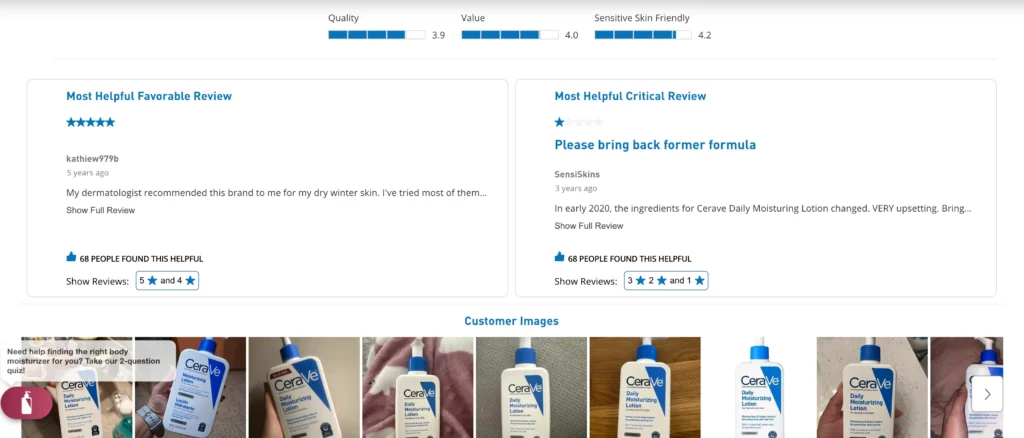
CeraVe has implemented a strategic approach to showcase customer reviews that enhances trust and credibility.
- Responds publicly to most reviews showing they listen
- Highlights positive testimonials in email and social content
- Redirects complicated cases to specialized team members
- Leverages reviews prominently across eCommerce site
Brand In Focus: Paula’s Choice

Paula’s Choice skillfully integrates customer feedback into its marketing and product development strategies.
- Invites feedback through reviews for product development
- Addresses questions transparently building community
- Reshares authentic transformations customers post
- Promotes reviews offsite with badges and snippets
Brand In Focus: The Ordinary

By actively encouraging and showcasing genuine customer testimonials, The Ordinary not only fortifies consumer trust but also leverages these reviews as a beacon of transparency and effectiveness.
- Responds to concerns swiftly within 24 hours
- Highlights consumer advocacy numbers prominently
- Reposts and spotlights authentic shelfies
- Links to external reviews driving SEO and trust
Handling Negative Feedback
When it comes to managing negative reviews, it’s imperative to maintain a professional and empathetic approach. Negative feedback, while often disheartening, provides an invaluable opportunity for growth and improvement.
- Prompt and Personalized Responses: Acknowledge the issue quickly and offer a personalized response that shows understanding and a willingness to resolve the problem.
- Resolution Offers: Where appropriate, offer solutions such as replacements, refunds, or discounts on future purchases to demonstrate your commitment to customer satisfaction.
- Follow-Up: After resolving the issue, follow up with the customer to ensure they are satisfied with the outcome. This can convert a dissatisfied customer into a brand advocate.
- Analysis and Improvement: Use negative feedback to identify areas for product improvement or customer service training. Share this feedback with relevant departments to inform future changes.
By actively managing customer reviews, you not only maintain control over your brand’s online reputation but also leverage real-world experiences to attract and retain customers. Positive reviews serve as powerful skincare marketing tools, while effectively handled negative feedback can showcase your brand’s dedication to exceptional customer service.
6. Build an Engaged Brand Community
A strong, vibrant brand community is the beating heart of any successful skincare brand. It’s where your most passionate customers become advocates, where conversations turn into conversions, and where your brand’s values and personality come to life.
In this step, we’ll explore the strategies for nurturing a thriving brand community that champions your products and embodies your brand ethos. From defining your brand’s personality to engaging with your audience on their preferred platforms, we’ll provide you with the tools to create a loyal and engaged community that grows alongside your brand.
Community Engagement Tactics
To foster community engagement, consider implementing interactive strategies that bring members together and encourage active participation:
- Host Regular Live Q&A Sessions: Schedule live streams where community members can ask questions and get real-time responses from brand representatives or guest experts. This can help build a sense of immediacy and connection.
- Create a Brand Ambassador Program: Identify and empower enthusiastic customers to become brand ambassadors. Provide them with exclusive perks, early access to new products, and insider information to share within the community.
- Run Community Challenges and Contests: Engage members with fun and thematic challenges or contests with prizes. For example, a “30-Day Skincare Challenge” encouraging members to share their daily skincare routine and progress.
Tools for Community Building
Leverage platforms that facilitate community building and management:
- Facebook Groups: Ideal for creating private or public spaces for your community to gather, discuss and share content.
- Discord: Offers a more interactive, real-time chat environment that’s great for younger demographics and fostering a sense of exclusivity.
- Branded Forums: Integrate a forum on your company website to give members a centralized place to engage with each other and your brand.
- Tribe: All-in-one community platform perfect for consolidating engaged brand fans in one space with dedicated mobile apps. Easy to use.
- Reddit: Host a Subreddit forum to participate in existing skincare conversations and directly engage your niche. Leverage popularity.
- Slack: Enable community collaboration and self-support through instant messaging and topic-based channels.
- Circle: Fosters inclusion through community voting on proposals and surfaced perspectives. Thoughtful approach.
- Front: Transition otherwise public community conversations to private direct messaging with team access for personalized support at scale.
- Communo: Incentivize sign-ups through reward programs while creating subgroups around shared interests and tiered access.
Brand In Focus: The Ordinary & reddit

The brand co-created the r/TheOrdinarySkincare community on Reddit which now boasts over 86,000 members discussing routines, reviewing products, and engaging peers for advice. The community has become a hub for exchanging valuable insights, sharing success stories, and offering support to fellow skincare enthusiasts.
Brand In Focus: Glossier & Slack

Glossier maintains an exclusive Friends of Glossier Slack group, which offers early access to launches and events in addition to building hype through messaging. The invite-only channel creates FOMO spurring sign-ups. This approach not only fosters a sense of exclusivity and belonging among its members but also serves as a feedback loop for the brand, allowing Glossier to fine-tune its product based on direct consumer insights.
Brand In Focus: CeraVe & Front

By integrating Front’s shared inbox, CeraVe empowers its community managers and brand reps to collaborate solving customer inquiries in one place at scale – crucial for large audiences. This centralized approach not only streamlines communication but also ensures that responses are consistent and aligned with the brand’s voice.
Brand In Focus: Drunk Elephant & Facebook Groups
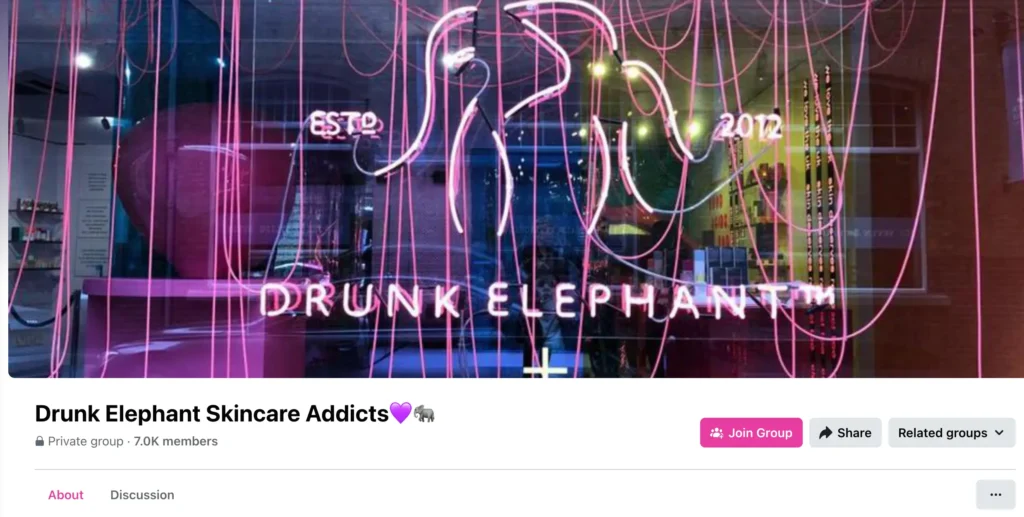
Drunk Elephant’s official Facebook community fosters 15,000+ lively conversations between devotees and ambassadors daily. The tribe shares updates, crowdsources guidance, and self-supports driven by a shared ethos. It’s a place where the brand’s most ardent supporters can connect over their mutual love for Drunk Elephant’s clean formulations, further solidifying the brand’s presence as a community-oriented and consumer-centric company.
Measuring Community Health
Track the health and engagement of your brand community through key metrics:
- Active Participation Rate: Monitor the percentage of active users contributing to the community versus the total number of members. A higher active participation rate indicates a more vibrant and interactive community, where members are not just passive observers but active contributors. This can include actions such as posting, commenting, sharing content, or participating in polls and events. Tracking this rate over time can help identify trends in engagement and the effectiveness of community-building initiatives.
- Member Growth: Keep an eye on the rate at which your community is gaining new members as an indicator of its appeal and reach. A steadily increasing membership suggests that your community is thriving, attracting new audiences, and successfully retaining them. It’s also reflective of the brand’s expanding influence and the effectiveness of its marketing efforts. Regularly monitoring this metric allows for timely strategies to maintain momentum and address any stagnation.
- Sentiment Analysis: Utilize tools like Brandwatch, Hootsuite Insights, and Mention to gauge the overall sentiment of discussions within your community, helping you understand member satisfaction and areas for improvement. By monitoring positive, negative, and neutral sentiments, you can identify patterns, track changes over time, and make data-driven decisions to enhance community engagement. Regular sentiment analysis can also alert you to emerging issues before they escalate, allowing for proactive community management and maintaining a positive brand image.
Summary
Implementing advanced skincare marketing strategies is an ongoing journey to master consumer sentiment, micro-trends and platform innovation. However, brands investing in strategic areas like research, branding, UX optimization and community enjoy outsized growth.
Frequently Asked Questions
Q: How much should skincare brands invest in influencer marketing on social media?
A: While influencer content attracts significant impressions, conversion rates are historically low. Focus first on improving site experience, reviews and community engagement for more measurable impact.
Q: Should emerging skincare brands sell via retailers or DTC?
A: Benefits exist in both models, but DTC allows greater control over brand identity and customer data collection crucial for agile start-ups. Relying solely on wholesale also impacts pricing flexibility.
Q: What is the ideal frequency for publishing beauty content?
A: According to Statusphere data, consistent posting without oversaturation is key. Aim for 8-10 new pieces monthly across your blog and social media. Repurpose evergreen content accordingly.
Q: How important are celebrity co-signs and brand ambassadors?
A: Big names drive awareness but payoffs are short-lived. Micro-influencers make better long-term partners for content and community building initiatives.


